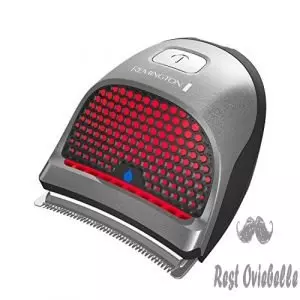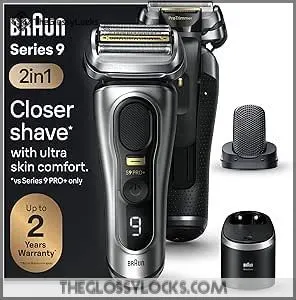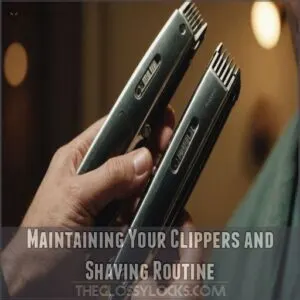This site is supported by our readers. We may earn a commission, at no cost to you, if you purchase through links.
 When you’re ready to take the plunge and shave your head, the right clippers make all the difference.
When you’re ready to take the plunge and shave your head, the right clippers make all the difference.
The best clippers for shaving your head balance power, comfort, and precision.
Top picks include the Remington Shortcut Pro for its 40-minute cordless runtime and ergonomic design, and the Braun Series 9 Pro for an ultra-smooth finish.
For professional-grade results, the Oster Classic 76 is unbeatable with its detachable blades and durable build.
Consider factors like battery life, blade quality, and whether you need wet/dry capabilities.
The key is finding clippers that feel like an extension of your hand – because let’s face it, nobody wants a patchy dome.
Table Of Contents
- Key Takeaways
- Top 5 Clippers for Shaving Your Head
- How to Use Clippers for a Smooth Shave
- Maintaining Your Clippers and Shaving Routine
- Frequently Asked Questions (FAQs)
- What is the difference between a head shaver and a hair clipper?
- What is the best Shaver for bald heads?
- What is the best men’s hair clipper?
- Should you use a hair clipper or a Shaver?
- What clippers are best for shaving your head?
- What do barbers use to shave bald heads?
- What is the best product to shave your head?
- Are head shavers better than clippers?
- Are balding clippers different from regular hair clippers?
- How long does a head shave with clippers last?
- Can you use clippers on wet or damp hair?
- Do expensive clippers give noticeably better head shaves?
- What clipper guard size gives the closest head shave?
- Conclusion
Key Takeaways
- You’ll want to consider battery life, blade quality, and wet/dry capabilities when choosing head clippers – the Remington Shortcut Pro offers 40 minutes of cordless use while the Braun Series 9 Pro provides premium waterproof performance.
- For maintaining your clippers, you should clean them after each use, oil the blades weekly, and replace blades annually to ensure optimal cutting performance and longevity.
- You can achieve the closest head shave by using a zero guard or no guard at all, but make sure to prepare your scalp first with pre-shave oil to prevent irritation, especially if you have sensitive skin.
- You’ll find that head shavers give a smoother finish than regular hair clippers – dedicated devices like the Skull Shaver Pitbull Gold PRO are designed specifically for scalp contours and typically provide 1-2 days of smoothness before stubble regrowth.
Top 5 Clippers for Shaving Your Head
Ready to rock that smooth dome? You’re in luck – we’ve rounded up the top 5 clippers that’ll turn your head into a gleaming masterpiece faster than you can say "baldilocks.
1. Remington Shortcut Pro Cordless Razor

The Remington Shortcut Pro Cordless Razor is a head-shaving powerhouse that’ll make you feel like a pro barber in your own bathroom.
With its extra-wide curved blade, you’ll conquer your dome in record time.
The 40-minute cordless runtime gives you plenty of juice for a thorough shave, and the quick 5-minute charge is a lifesaver when you’re in a rush.
You’ve got options galore with 9 length combs, perfect for experimenting with different styles.
Plus, it’s 100% washable, so cleanup’s a breeze.
Just remember, it’s not for the baby-smooth look – you might need a hand razor for that.
Best For: The Remington Shortcut Pro Cordless Razor is best for men who want a fast and easy way to trim their hair at home.
- Extra-wide curved blade for quick and efficient trimming.
- 40-minute cordless runtime for a thorough shave.
- 9 length combs for a variety of styles.
- Does not provide a smooth-to-the-scalp shave.
- Requires a full charge for optimal performance.
- Some users have reported issues with combs breaking if dropped.
2. Braun Series 9 Pro Electric Razor

Ready to take your head-shaving game up a notch? Braun’s Series 9 Pro Electric Razor might just be your new best friend.
This German-engineered marvel boasts a ProComfort head that’ll have you smooth as a cue ball in no time.
If you’re still unsure about the best clippers for your needs, check out top-rated clippers reviews.
With its 5 synchronized shaving elements and SyncroSonic tech, it adapts to your beard like a chameleon.
Plus, it’s 100% waterproof, so you can shave in the shower without a care.
The 60-minute battery life and quick charge feature mean you can shave in the shower without a care.
The 60-minute battery life and quick charge feature mean you can shave in the shower without a care.
The 60-minute battery life and quick charge feature mean you can shave in the shower without a care.
Best For: This razor is best for guys who want a close, comfortable shave and are willing to pay a premium price for it.
- It provides a close, comfortable shave thanks to the ProComfort head and 5 synchronized shaving elements.
- It’s waterproof and can be used in the shower.
- It has a long battery life and quick charging feature.
- Some users found the rectangular head difficult to use on certain face shapes.
- Some users found the shaver to be loud.
- The shaver comes with a 2-pin plug, requiring an adapter for some users.
3. BaBylissPRO Double Foil Shaver GOLDFX
Ever dreamed of a shaver that’s worth its weight in gold?
Enter the BaBylissPRO Double Foil Shaver GOLDFX.
This full-size metal marvel boasts hypoallergenic gold foils and a powerful rotary motor for an extra-close shave.
With a 3-hour runtime, you’ll have plenty of juice to tackle your dome.
But hold your horses – it’s not designed for head hair.
Use a trimmer first to avoid any hair-raising experiences.
While it might pinch and pull on longer stubble, it’ll leave your face and neck smoother than a baby’s bottom.
Just watch out for those random stragglers!
Best For: The BaBylissPRO Double Foil Shaver GOLDFX is best for those with short facial hair who want a close shave on their neck, face, and hairline.
- Hypoallergenic gold foils, ideal for sensitive skin shaving, are often preferred for their gentle shaving experience. Hypoallergenic gold foils for sensitive skin
- Powerful rotary motor for an extra-close shave
- 3-hour runtime for multiple uses
- Can leave random hairs on the face and neck
- Can pinch and pull on longer facial hair
- Heavy and large
4. Oster Professional Hair Clippers Classic 76

Looking for a clipper that can handle the toughest hair?
Meet the Oster Professional Hair Clippers Classic 76.
This powerhouse boasts a single-speed universal motor that’ll slice through any hair type like a hot knife through butter.
With its ultra-durable burgundy housing and ergonomic design, you’ll feel like a pro barber in no time.
The 9-foot power cord gives you plenty of room to maneuver, while the detachable blades make cleanup a breeze.
Just remember, with great power comes great responsibility – this bad boy’s meant for heavy-duty use, so handle with care!
Best For: The Oster Classic 76 is best for barbers, stylists, and anyone looking for a professional-grade clipper that can handle heavy-duty use.
- Powerful motor for all hair types
- Durable and ergonomic design for comfortable use
- Includes essential accessories like a blade guard, oil, and brush
- Lacks a storage case
- Requires specific voltage converters for international use
- Higher initial investment compared to basic clippers
5. Cordless Electric Head Shaver

The FlexSeries Electric Head Shaver is a smooth operator for your dome.
With its 5-blade rotary system, you’ll glide through your shave like butter on a hot skillet.
It’s a jack-of-all-trades, offering wet or dry shaving and a 90-minute battery life.
You’ll feel like a grooming guru with its arsenal of attachments, including a precision trimmer and exfoliation brush.
While it might nick your wallet a bit, its anti-bump tech keeps your scalp happy.
Just remember, even the best tools need TLC – clean it regularly to keep it purring like a well-oiled machine.
Best For: Guys who want a smooth, close shave with minimal irritation and are looking for a cordless shaver with a long battery life. For those considering cordless shavers, understanding the differences between a cordless shaver vs trimmer can help inform the decision. Guys who want a smooth, close shave with minimal irritation and are looking for a cordless shaver with a long battery life.
- Achieving a smooth and close shave requires choosing the right balding clippers, such as those with premium clipper features, that consider factors like quality, price, and versatility. Smooth and close shave
- Minimal irritation (razor bumps)
- Powerful and efficient
- Some users report irritation on the neck/throat
- Accessories may not be useful for all users
- Blade replacement recommended every 50 shaves (may be a cost consideration)
How to Use Clippers for a Smooth Shave
You’ll find that getting a smooth head shave isn’t rocket science once you’ve got the right technique and tools.
Whether you’re a first-timer or a seasoned head-shaver, we’re going to show you how to use your clippers like a pro for that perfect chrome-dome look.
Preparing Your Skin for Shaving
A man’s scalp deserves a luxurious spa day before meeting the clippers.
Start by hopping in a steamy shower – your skin’s equivalent of rolling out the red carpet.
Gently exfoliate to sweep away dead skin cells, then apply pre-shave oil to create a silky-smooth runway for your clippers.
If you’ve got sensitive skin, don’t skip this step – it’s your shield against irritation and razor burn.
Tips for Using Clippers on Different Hair Types
Success with your clippers depends on understanding your unique hair type.
You’ll master your mane when you master cutting power to texture – whether you’re rocking fine strands or tackling coarse curls.
For the best results, consider investing in a reliable head shaver from a trusted retailer like Everysimply Head Shavers.
Here’s your game plan:
- Fine hair: Use narrow blade teeth and gentler pressure
- Thick or coarse hair: Opt for wider blades with more cutting power
- Curly hair: Go slow and steady, working with your natural growth pattern
Feel like a pro yet? You’re on your way!
How to Maintain Your Clippers for Optimal Performance
Now that you’ve mastered different hair types, let’s keep your trusty head shaver in tip-top shape.
Regular blade sharpening and oiling will make your clippers purr like a well-fed cat.
After each use, brush out those stubborn hair bits and give the blades a quick wipe-down.
Think of clipper cleaning as a mini spa day for your tools – they’ll thank you with years of smooth, snag-free service.
Store them in a dry spot, and they’ll always be ready for action.
Maintaining Your Clippers and Shaving Routine
You’ll get the most out of your clippers when you treat them right, just like how a chef takes care of their knives.
Using the right hair clipper sizes, understanding that they range from 0 to 8, with 0 being the shortest and 8 the longest, considering your haircut number is essential for achieving a smooth head shave. Keeping your clippers clean and well-maintained extends their life but also guarantees you’ll get that perfect, smooth head shave every time you buzz.
Cleaning and Lubricating Your Clippers
Keeping your balding clippers in tip-top shape is like giving your car an oil change – it’ll run smoother and last longer.
After you’ve mastered your shaving technique, let’s talk maintenance.
For those who want to go the extra mile, learning how to sharpen clipper blades can make a big difference in clipper performance.
Here’s what you’ll do:
- Brush off hair after each use with the cleaning
- To keep your clippers in top shape, besides oiling, follow the clipper blade care tips. Oil the blades weekly with quality hair clipper oil
- Disinfect blades monthly with clipper spray
- Check blade alignment every few weeks
- Replace blades annually for top performance
A well-maintained clipper doesn’t just cut better – it’ll be your trusty sidekick for years to come!
Common Mistakes to Avoid When Shaving Your Head
With your clipper maintenance down pat, let’s tackle some head-shaving slip-ups that can turn your smooth buzz cut into a buzzkill.
You’ll want to avoid shaving too short right off the bat – rookie mistake!
Invest in a reliable electric shaver for head shaving like this one, which can make a big difference.
Watch out for dull blades that can lead to nasty razor burn, and don’t rush the process by using the wrong angle.
Think of your head like a delicate canvas – it deserves the right products and a steady hand.
Frequently Asked Questions (FAQs)
What is the difference between a head shaver and a hair clipper?
Hair clippers leave some stubble, like a buzz cut, while head shavers give you that smooth, clean-dome look.
Think of clippers as your lawn mower and shavers as your precision garden trimmer for your scalp!
What is the best Shaver for bald heads?
Perfectly polished pates prefer the Skull Shaver Pitbull Gold PRO!
You’ll love its palm-perfect fit and flexible blades that contour to your head.
It’s water-resistant and delivers 90 minutes of cordless, close-shave freedom.
What is the best men’s hair clipper?
You’ll love the Wahl Professional 5 Star Series Senior Clipper for its trusted performance and durability.
It’s got a strong motor that’ll slice through any hair type, though beginners might find it a bit powerful.
Should you use a hair clipper or a Shaver?
Time to pick your weapon of choice!
For stubble or a close-to-skin look, grab clippers.
Want that baby-smooth dome? A dedicated head shaver’s your best bet.
Both tools have their sweet spots.
What clippers are best for shaving your head?
Grab the Wahl Professional Balding Clippers for a clean, close shave.
They’ve got a powerful motor and durable guide combs.
For ultimate control, try the Andis Master – it’s built tough and handles any hair type.
What do barbers use to shave bald heads?
Professional barbers swear by powerful, precise tools like the Wahl Professional Balding Clippers or Andis Master. They’ll slice through stubble effortlessly, leaving your dome as smooth as a cue ball.
What is the best product to shave your head?
You’ll love the Skull Shaver Pitbull Gold PRO for your head-shaving needs.
It’s water-resistant, has a 90-minute battery life, and its flexible blades contour perfectly to your head for a close, comfortable shave.
Are head shavers better than clippers?
Head shavers give you a smoother, closer finish than clippers.
Designed specifically for scalp contours, they’re often waterproof and faster.
But if you prefer some stubble, trusty clippers might be your better bet.
Are balding clippers different from regular hair clippers?
Did you know balding clippers cut twice as close as regular ones?
They’re designed with sharper blades and stronger motors to tackle stubborn scalp hair, giving you that smooth, clean-shaven look you’re after.
How long does a head shave with clippers last?
A clipper shave typically lasts 1-2 days before stubble appears.
For longer-lasting results, try zero-gapping your clippers or using a razor after clipping.
Your hair growth rate ultimately determines regrowth speed.
Can you use clippers on wet or damp hair?
To minimize frizz and prevent damage, consider gently blotting excess moisture with a microfiber towel for around 10-15 minutes before using clippers. Keep your hair dry when using electric clippers.
Wet hair clumps up, causing uneven cuts and potential clipper damage.
For the smoothest, most precise shave, make sure your locks are completely dry before buzzing.
Do expensive clippers give noticeably better head shaves?
Million-dollar motors won’t magically transform you into a chrome-dome deity!
You’ll notice premium clippers offer smoother cuts, longer lifespans, and consistent performance.
But mid-range options can still give you that sleek, professional finish you’re after.
What clipper guard size gives the closest head shave?
You’ll get the closest head shave using a zero guard or no guard at all.
Most professional clippers can be zero-gapped for that ultra-smooth finish, leaving just a hint of stubble behind.
Conclusion
Like a barber’s trusty scissors, the best clippers for shaving your head become an extension of your grooming routine.
Whether you choose the ergonomic Remington Shortcut Pro or the professional-grade Oster Classic 76, finding the right tool transforms head shaving from a chore into a confident ritual.
Remember, proper maintenance keeps your clippers sharp and reliable.
With the right technique and equipment, you’ll achieve that smooth, polished look that turns heads – for all the right reasons.
Time to embrace the bald and beautiful life!





